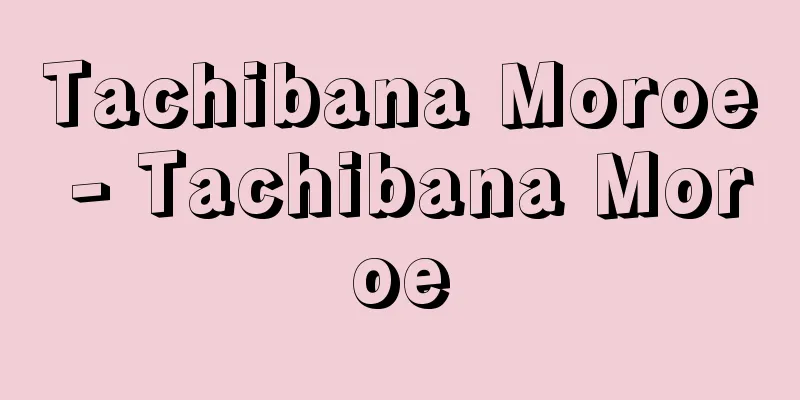Tachibana Moroe - Tachibana Moroe

|
A politician of the Nara period. He was the son of Emperor Bidatsu's great-great-grandson Prince Minu. Naramaro was his eldest son. He was called Prince Katsuragi. His mother was Agata Inukaino Tachibana Michiyo. He was favored by his mother and her future husband Fujiwara no Fuhito, and married Fuhito's daughter Metahin. In 736 (Tenpyo 8), he was demoted to the status of a commoner, given his mother's surname Tachibana no Sukune, and called Moroe. In 710 (Wado 3), he was promoted to the rank of Junior Fifth Rank, and in 729, he was appointed as a land distribution messenger. Eight of his waka poems, including the one he sent to Satsumyokan in that year, are included in the Manyoshu. In 731, he was appointed as a councilor, and the following year he was promoted to the rank of Junior Third Rank. In 737, when many high-ranking officials, including the Minister of the Left Fujiwara Muchimaro, his third brother, and the Middle Counselor Tajihi no Agatamori, died of smallpox, he was appointed Dainagon in the same year and Minister of the Right the following year, and remained at the head of government as Ichinokami for 18 years until his retirement in 756 (Tenpyo Shoho 8). The Fujiwara clan was absent from government for a while, and did not fare well. In the autumn of 740, Dazai no Shoni Fujiwara Hirotsugu led a large army in rebellion in Kyushu. The pretext was to remove the monks Genbo and Kibi no Makibi, but since both were the brains behind the Shohei administration, it is assumed that the intention was actually to expel the Shohei and restore the Fujiwara administration. During the rebellion, the Emperor made a trip to Ise in the eastern provinces at the end of October, and instead of returning to Heijō, he went to Kuninomiya Palace in Soraku County, Yamashiro Province (Kyoto Prefecture) in December and made it the imperial capital. This place was close to the Shohei's main residence, and it is said that the move of the capital was planned by the Shohei. In 741, a petition was made to build a provincial temple and a nunnery, and an imperial decree was issued. The construction of Shigaraki Palace in Omi and frequent visits to the palace were also seen, and in 743 the Emperor issued an edict to pray for the construction of a Great Buddha there. The following year, in leap year's New Year, the Emperor visited Naniwa Palace, and in February an edict was issued designating Naniwa as the imperial capital, which may have been due to the policies of the various ministers. The Emperor went to Shigaraki and promoted the construction of a Great Buddha, but was met with much opposition and was unable to achieve his goal, and he eventually moved the capital back to Heijō. The Great Buddha was completed at Todaiji Temple in Heijō. During this time, the power of the Shoke gradually declined, and Fujiwara no Nakamaro's power grew, deepening the conflict between the Shoke and Naramaro father and son. During the reign of Empress Kōken, Empress Kōmyō and Nakamaro seized power, and the Shoke fell into despair. In 755, he was accused by his attendant, Sami no Miyamori, of disrespect in the garden drinking alcohol during the death of the retired emperor. Although the retired emperor pardoned him, he retired from service. He died on January 6, the first year of Tenpyō-hōji. [Kenichi Yokota] Source: Shogakukan Encyclopedia Nipponica About Encyclopedia Nipponica Information | Legend |
|
奈良時代の政治家。敏達(びだつ)天皇の玄孫美努(みぬ)王の子。奈良麻呂(ならまろ)はその長男。葛城王と称した。母は県犬養(あがたいぬかいの)橘三千代(たちばなのみちよ)。母と母の後の夫藤原不比等(ふひと)に引き立てられ、不比等の女多比能(むすめたひの)をめとる。736年(天平8)臣籍に降(くだ)り、母の姓橘宿禰(すくね)を賜い諸兄と称した。710年(和銅3)従(じゅ)五位下に叙し、729年班田使に任ぜられた。この年に薩妙観(さつみょうかん)に贈った歌をはじめ和歌八首が『万葉集』に収められている。731年参議に任じ、翌年従三位(さんみ)に昇叙。737年左大臣藤原武智麻呂(むちまろ)をはじめその三弟、中納言多治比県守(ちゅうなごんたじひのあがたもり)らの高官多数が疱瘡(ほうそう)のため死ぬと、諸兄は同年大納言、翌年右大臣に任ぜられ、以来一(いち)の上(かみ)として756年(天平勝宝8)致仕するまで18年間政権の首座にあった。藤原氏はしばらく政権から離れ振るわなかった。 740年秋、大宰少弐(だざいのしょうに)藤原広嗣(ひろつぐ)が九州で大軍を率いて叛(はん)した。その名目は僧玄昉(げんぼう)と吉備真備(きびのまきび)を除くということにあるが、両名が諸兄政権のブレーンである点よりみて、実は諸兄排斥、藤原政権回復を意図したものと推定される。乱中、天皇は10月末東国伊勢(いせ)に行幸、そのまま平城に還(かえ)らず、12月に山城(やましろ)国(京都府)相楽(そうらく)郡恭仁(くに)宮に入り、これを皇都とした。この地は諸兄の本貫に近く、遷都は諸兄の計画によるとされている。741年国分寺、同尼寺建立が発願され詔が降った。また近江(おうみ)紫香楽(しがらき)宮の造営とそれへの頻繁な行幸がみられ、743年、天皇はこの地で大仏建立発願の詔を降した。しかるに、翌年閏(うるう)正月難波(なにわ)宮行幸があり、2月に諸兄の宣で難波を皇都とする詔が出たのは諸兄の政策によるのかもしれない。天皇は紫香楽に行き、大仏造立を推進したが、反対多くて果たさず、ついに平城に還都した。 大仏は平城の東大寺で完成した。この間に諸兄の実権はしだいに衰え、藤原仲麻呂が実力を伸長し、諸兄、奈良麻呂父子との対立は深まった。孝謙(こうけん)天皇時代に光明皇太后と仲麻呂が政権を掌握、諸兄は失意にあり、755年彼の祗承(しぞう)人(左右にいて仕える人)佐味宮守(さみのみやもり)に、太上天皇不予の際、飲酒の庭で礼なしと告訴され、太上天皇に許されたが致仕した。天平宝字(てんぴょうほうじ)元年正月6日没。 [横田健一] 出典 小学館 日本大百科全書(ニッポニカ)日本大百科全書(ニッポニカ)について 情報 | 凡例 |
Recommend
Crow invitation - Karasukanjo
...Atsuta Shrine in Nagoya, Taga Taisha in Omi, a...
NEACP
...If an airborne command aircraft is equipped wi...
Liquefaction necrosis (English spelling) Liquefaction necrosis
… Eventually, the necrotic tissue is processed an...
Family Ranidae - Red frog
…A general term for frogs of the Ranidae family. ...
Import substitution - Yunyuudaitai (English spelling) import substitution
It refers to a country achieving partial or total ...
Sadao Maruyama
A modern theater actor. Born in Ehime Prefecture....
Mauclair, C. (English spelling) MauclairC
...The young Symbolist poets who looked up to Mal...
Transference - Ginkgo
〘 noun 〙 ("I" is a document exchanged be...
Space group - クウカングン
A space group is a group formed by a set of symmet...
Kiyone [village] - Kiyone
A village in Tsukubo County in southern Okayama Pr...
Hiwaki [town] - Hiwaki
A former town in Satsuma County, central Kagoshima...
Object-oriented programming language
... The idea of combining such data structures ...
Allied forces - Allied arms; combined forces
A military force formed by the combined armies of ...
Grandier, U. (English spelling) GrandierU
...In a demon possession case set in a 17th centu...
Boat (English spelling) ship
A vehicle that carries people or things across the...





![Kazbek [mountain] - Kazbek](/upload/images/67cb3476997e3.webp)



